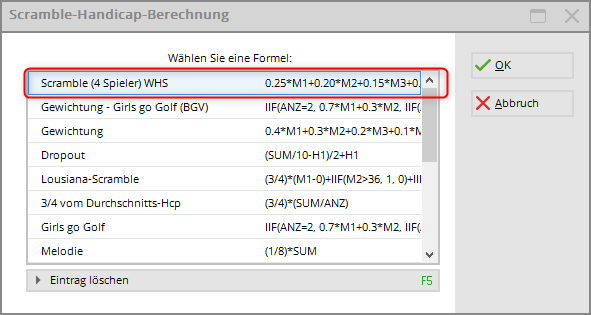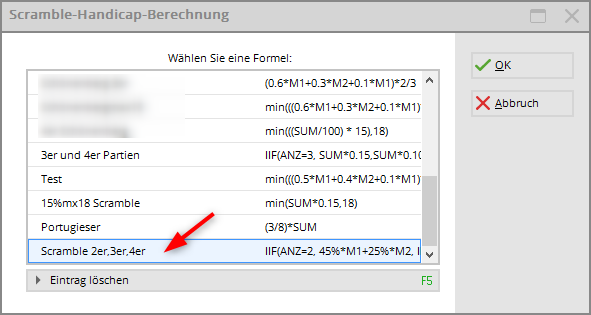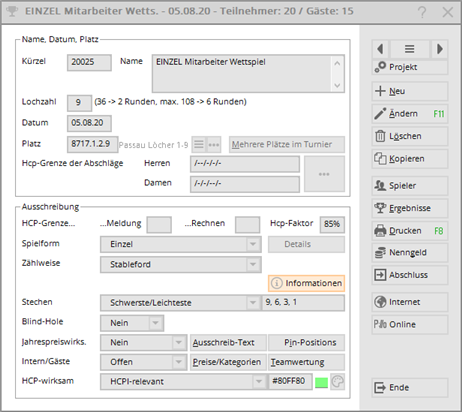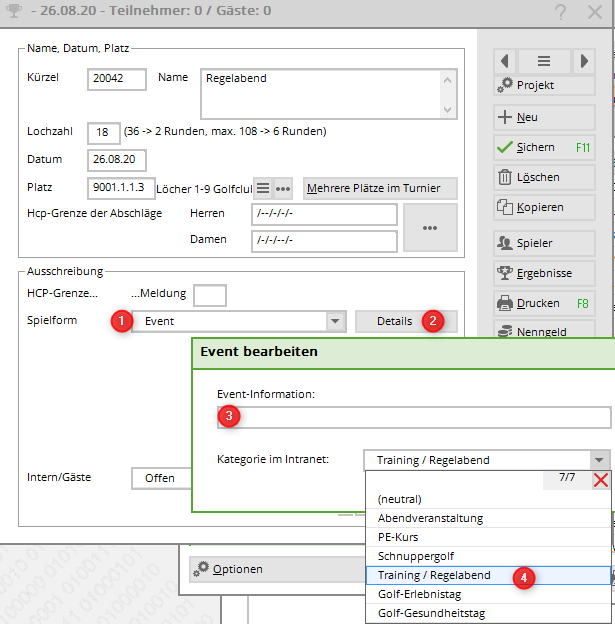Inhaltsverzeichnis
WHS general tournament information
In particular, read here Explanations of the different game forms and calculations of the game handicaps.
The introduction of the WHS (World Handicap System) causes some changes to the calculation of the game handicap for different game forms! Please pay particular attention to the information on 2-way scramble and scramble (the formula for scramble must be actively selected in the formula selection for every competition!)
New terms and abbreviations
- WHS - World Handicap System
- Handicap-Index - HCPI (analogous to the handicap in the previous EGA system)
- Course-Handicap (according to the Course rating table for single players
- Playing-Handicap - joint handicap for four players, or a reduced handicap also for a single player with a handicap factor of 90%, for example, or 100% handicap.
- Penalty Score: fictitious result, is entered for the player who has not submitted a HCPI-relevant result (see rule 7.1b of the handicap rules, valid from 2021, licensed for the DGV).
Here you can find the DGV Service Portal and the information about the WHS:
https://serviceportal.dgv-intranet.de/regularien/vorgabensystem/world-handicap-system.cfm
Season HCPI relevant
we do not yet have any detailed information (as of October 21, 2020) for Switzerland and Austria
Germany
Only HCPI-relevant competitions are permitted on the DGV intranet and also accepted with the results during the season (May to September). This is controlled by checking the HCPI relevance.
Exceptions must be clarified by the club with the DGV. Both HCPI-relevant and NOT HCPI-relevant games can be played outside the specified season (October to April).
HCPI relevance test (Germany)
When you send a competition to the intranet, the setting for HCPI relevance is automatically checked by the DGV and a response is sent, which you can then see in the information window:
Tournament completion for HCP index
You can read about this here.
Penalty Score
A penalty score is added to a player's master sheet, this is determined by the captain.
Please read the “Handicap rules, valid from 2021, licensed for the DGV”.
A short email to handicap@dgv.golf.de sent by the club (captain) is enough for sending the request tp DGV.
Single
The mostly used formula for the calculation of the playing handicaps is:
Playing handicap = exact handicap x Slope / 113 – CR + Par
(See DGV handicap and game rules 1.13, Page 23 - As of: 2012-2015)
In some tournaments the playing handicap is also influenced by the fields „HCP limit …Calculation“ or „Hcp factor“. The „HCP limit“ is setting the upper limit of the handicap, i.e., a golfer's handicap can be at most as high as the value entered here. You can use this handicap limitation in every handicap qualifying tournament, given that PC CADDIE will transfer the correct Stableford points into the handicap record sheet based on the correct exact handicap.
The „Hcp factor“ will be calculated from the playing handicap. For example: if you enter „3/4“, a golfer with a normal handicap of 20 will participate in the tournament with a handicap of 14. A tournament like this will never be handicap qualifying.
Example of playing handicap calculation
- The minus in front of every handicap is very important is . This is not really used in the daily golf business, but it is part of the calculation.
- A player with the exact handicap of „-22,3“ playing on a course with the slope rating 132, course rating (CR) 71,3, and par 72, has the following playing handicap:
The course rating table is also calculated Course Rating Table according to this example.
Bogey-Competition
In a bogey competition the golfers are playing against the par of the golf course. The golfer is getting the number of handicap strokes according to his playing handicap.
The result is calculated as a +, 0, or - per hole. At the end, the pluses and minuses will be added up. This playing format can also be played as a handicap qualifying tournament. PC CADDIE is automatically calculating the Stableford points.
Rad more in our practical example: Bogey-Competition.
The Stableford points will not be calculated hole by hole, but rather by adding 36 to the total result. This means, a total result of +2 (= „2 up“) will result in 38 Stableford points. This is important because bogey-competitions are played strategically different, and the player may pick up his ball earlier than in a normal Stableford competition.
(see also the DGV handicap and game rules, Page 69 - As of: 2012-2015)
HCP limit for four-balls
The field Entry is used for single tournaments.
The field HCP limit… … Calculation is limiting the exact handicaps of the players in the various four-ball tournaments, as follows:
- If the handicap limit is smaller than or equal to 45, this limit will be calculated for each player (in single as well as four-ball tournaments)' this means: if you enter the handicap 28.0, a golfer with the exact handicap of 33.2 will be sorted in the result list with an exact handicap of 28.0.
- If the handicap limit is over 45, PC CADDIE is calculating this as an upper limit of the total exact handicaps (for both players). If you enter the handicap limit 48.0 for two players with the exact handicaps of 33.2 and 18.5, it will be internally considered that their handicaps are 30.8 and 17.2, so that the sum of the handicaps is exactly at the desired upper limit.
Explanation: The mostly used limits for both handicaps are 48 or 56 as a maximum for the combined exact handicap (the sum of the handicaps).
The Hcp limit…Calculation 54 for a single play is not necessary, as it is anyway not possible to calculate more than 54. If a pair of golfer exceeds this limit, both of them will be considered with proportionally lower handicap.
A simple example: Consider that the limit of the combined handicap is set to 48, and the two players have the handicaps 54 and 42, , so their combined handicap is twice as high as the limit. In this case, the calculated handicap for both players will be half as high as their normal ones, so that the combined one is 48. This means that, for this particular tournament, it will be considered that one has 27.0, and the other one 21.0.
More sample calculation also with Hcp limit 48:
Player 1 has the normal handicap 22.2 and player 2 has 35.9, so the combined one is 58.1, so greater than 48 – the question now is, how to downsize their handicap so that the combined one is 48?
This is how we calculate:
Normal handicap: 22,2
⇒ Playing handicap: 22.2*(48/(22.2+35.9)) = 18.3
Normal handicap: 35,9
⇒ Playing handicap: 35.9*(48/(22.2+35.9)) = 29.7
In the end we have 18.3 +29.7 = 48, the hcp limit
Tee-off in four-ball games for players with the dame handicap
The calculation of the common HANDICAP is ALWAYS done based on the individual players' tees
For four-balls, however, one should consider whether every detail setting makes sense, since there is anyway only 1 result per pair.
The following should be considered when calculating the scores and the end results for pairs with different tees:
- According to golfing regulations the men's tee is always used in mixed games; this concerns the par values as well as the distribution of the handicap (the rules for the men's four-balls apply for mix matches since 2013).
- In the case of 2 same-gender players, the better player's tee is taken for the calculation (par values with pre-allocation).
- Attention: For special pairs, for example the man with green tee and the second player being a woman, the par value of the male player is taken for the result calculation, GREEN. This could lead to alleged injustice because for another pair with a female player from green and a male player from yellow, the result is calculated from the YELLOW tee, and for 2 male players of GREEN and YELLOW, the player considered is the one with better results.
- Therefore you should always decide whether in the case of a four-balls game you consider all the tees or the first tee for men and one per women. There are also other possibilities, for example that the children always start from the GREEN tee.
CR compensation
Find all the important information on CR compensation for both single and foursome games ⇒here
Aggregate
Aggregate is a playing format with a team of two golfers, where each player is playing his own ball.
The normal playing handicap is calculated per team player, per round.
The results of both players will we added.
This playing format is possible as a Stableford, stroke play or as a bogey competition.
(DGV handicap and game rules 3.3, Page 188 - As of: 2012-2015)
If you are playing an aggregate tournament, handicap qualifying, you have to choose the format single „Single“ and organize the result list for the aggregate with the help of the team scoring:
handicap qualifying aggregate tournament
This is important, because in a handicap qualifying aggregate the team players are not allowed to play both in the same flight.
Foursome
In this playing format two golfers are alternatively playing one ball.
The playing handicap is half of the total of both playing handicaps, this means, both players are playing with the average of the two single handicaps. In a stroke play tournament it can happen that the playing handicap is with decimal point; for example if the two golfers have handicaps of 15 and 10, the playing handicap will be 12,5.
(See DGV handicap and game rules 3.3, Page 186 - As of: 2012-2015)
Greensome
Both players tee off and choose the better ball for the second shot and continue like in a foursome. If none of the balls can be played (for example both are “Out of bounds” or lost), the choice regarding from where to continue the game is governed by the rules applied to the respective game. The alternate playing of the same ball needs to be respected in any case.
The playing handicap is calculated as 0,6 of the lower playing handicap and 0,4 of the higher handicap. Both figures are added up before rounding.
(See DGV handicap and game rules 3.3, Page 187 - As of: 2012-2015)
Chapman-Four-ball
The game begins the same way as the greensome, then each golfer plays the other's ball for the second shots. The best of the second shots is selected, and from there the two partners play alternate shot into the hole.
In Germany and Austria, the playing handicap is calculated according to the normal foursome: Half of the total playing handicaps of both players.
(See DGV handicap and game rules 3.3, Page 187 - As of: 2012-2015)
In Switzerland, the playing handicap is calculated according to the normal greensome: 0,6 of the lower playing handicap and 0,4 of the higher handicap. Both figures are added up before rounding.
Four-ball
In a four-ball, both golfers are playing their own ball. The score will be the best obtained by one of the players for each hole. There are no penalties if only one of the golfers plays a hole.
The marker needs to write down the score of the player with the best score per hole. Writing down the best result must include information regarding which golfer achieved that result, otherwise the team will be disqualified.
The conventional stroke tournaments (Stableford) are actually „four-balls“. It is often called „Four-ball/better ball“ because the best ball is the only one that actually matters for the result. Also with the WHS, the DGV recommends the use of the factor 9/10 for the determination of individual game specifications of the partners, which PC CADDIE uses by default, if nothing else has been set. However, the factor may be set individually depending on the competition announcement and stored in the Hcp factor field in PC CADDIE.
It is important, that each player is writing down their own result per hole on the scorecards. This will be entered in PC CADDIE . Therefore PC CADDIE is calculating the best score per hole for the teams (considering two different handicaps of the two players). It may happen that one golfer's result is the best one for a hole in a net results list, while other golfer's result is the best in a gross results list, for the same hole.
You may leave the holes with no scores empty (no stroke), especially in a stroke tournaments. Thus PC CADDIE can check if there is at least one result per hole.
A four-ball will never be a handicap qualifying tournament.
(See Rule 31 as well as DGV handicap and game rules 3.3, Page 187/188 - As of: 2012-2015)
Four-ball strokeplay:
The playing handicap for each player is calculated individually and multiply with a factor. The factors 9/10 or 3/4 are mostly used.
PC CADDIE usually takes 3/4 of the difference to the lowest handicap; for example, if the lowest playing handicap in flight is 6 and one of the other handicaps is 15, PC CADDIE is calculating 15-6=9 and after applying the factor 3/4 the result is 6.75, so the golfer has a playing handicap of 7.
PC CADDIE is setting the lowest handicap to 0.
WHS Scramble with 2 players
New formula with World Handicap System!! Please note!
Addition of 35% of the lower and 15% of the higher course handicap of the partner ;
Sum of the strokes rounded up (from 0,5) or down (if less than 0,4).
The Ryesome foursome in Austria is the same form of play as the Scramble with 2 players in Germany.
Scramble (Texas - und Florida Scramble)
New formula can be selected from the selection of formulas recommended with WHS from 2021! Please continue reading!!
Scramble is usually played in teams of 3 or 4!
Explanation
A scramble is a team playing format, where the flight is building a team. All players of the team are teeing off and then deciding for the best ball. From this position, each player is again playing his own ball. There is just one result per hole and per team, independent whether there are 3 players or 4 players.
In Texas Scramble each golfer plays again from the best ball position; in a Florida Scramble, the person with the best position does not play the next shot.
AScramble Stableford is always played with rounded handicap.
Playing Handicap - calculation
The following formula is recommended with the WHS - World Handicap System; this is available when selecting the formula (under 2.):
25% / 20% /15% / 10% from the lower to the higher course handicap
The calculation of the scramble, where no other specifications are made, is:
| Teachers scramble | |
|---|---|
| Total handicap limit | 100 |
| Handicap bonus ladies | 5 |
| Handicap faktor | 10 % |
This means: all individual handicaps for the game are added; if the total is over 100, the calculation continues with 100 (limit 100). 5 are added per lady in the game, which then gives 110 for 2 women, and 10% of this gives Hcp 11 for the game.
If the individual game handicap add up to 88 and 1 woman is in the game, 88 + 5 = 93, of which 10% results in SPV9.
But the calculation can be also made based on a previously entered formula. Please note that you cannot use commas when entering the formulas. For numbers like, for example, 0,4, please enter 0.4.
By clicking the button HCP-Berechnung in the tournament window and then the button Select you will find various default formulas:
You can also create a new formula which will be used for future tournaments. After creating a new formula PC CADDIE automatically asks you to provide a name for it.
From now on this new formula is always available.
Scramble with 3 or 4 players
TIPP: the “Girls go Golf” formula can also be adjusted for this and saved under a new name! There is no automatic adjustment for the WHS !!
Despite the name, this long formula has nothing to do with girls, but it was originally only programmed for games played by girls.
The formula ensures that the players' HCPs are weighted differently for different flight sizes:
IIF(ANZ=2, 0.7*M1+0.3*M2, IIF(ANZ=3, 0.5*M1+0.3*M2+0.2*M3,0.4*M1+0.3*M2+0.2*M3+0.1*M4))
If the game consists of only 2 players (unusual for scramble, but it could happen if one does not appear in a game of 3), then the better HCP (M1) is weighted with 70%, the 2nd player (M2) with 30%.
If there is no flight of two in the game, this part of the formula has no effect.
IIF(ANZ=2, 0.7*M1+0.3*M2, IIF(ANZ=3, 0.5*M1+0.3*M2+0.2*M3,0.4*M1+0.3*M2+0.2*M3+0.1*M4))
If the flight consists of 3 players (with scramble you rarely make it all the same size), then the better HCP (M1) is weighted with 50%, the second best HCP (M2) is weighted with 30%, and the 3rd player (M3) with 20%.
If there is no flight of three in the competition, this part of the formula has no effect.
IIF(ANZ=2, 0.7*M1+0.3*M2, IIF(ANZ=3, 0.5*M1+0.3*M2+0.2*M3,0.4*M1+0.3*M2+0.2*M3+0.1*M4))
If the flight consists of 4 players (usually common for scramble), then the better HCP (M1) is weighted with 40%, the second best HCP (M2) is weighted with 30%, the 3rd best HCP (M3) with 20% , and the highest HCP with 10%.
Ryesome Four-ball
A scramble with 2 players is called a „Ryesome“ in Austria. The playing handicap is calculated the same as for the scramble with 2 players: Addition of 35% of the lower and 15% of the higher course handicap of the partner ;
Sum of the strokes rounded up (from 0,5) or down (if less than 0,4).
Pro-Am and Am-Am
A team score is usually used for these playing formats, but it is also possible to have single results. The tournament is usually played a a single, each player having his own score. There are various possibilities for calculating the Team score, which can be accessed by clicking on the Wizard button.
String it out
Each player is getting a piece of string according to his handicap. To improve the lie of a ball (without adding a stroke), the player strings it out in the direction he wants to move the ball. If the string reaches the point where the player wants to place his ball, he can move it and cut the corresponding length from the string. The player has to finish the round as usual when there is no string left.
Course Handicap (Playing Hcp) in tournaments over less than 18 holes
In principle, PC CADDIE can administer any number of holes. Tournaments over 18 holes, and according to the rules, also over 9 holes can be handicap qualifying. The playing handicap will be spread over 18 holes or counted partly according to the number of holes. This means: a player with handicap 26 in 9 hole stroke play tournament is credited only half (9/18).
This is the same with fun tournaments or cross country tournaments:
Is there a tournament over 12 holes, the deduction is 12/18th of the normal playing handicap (for our example with the handicap 26, this means 17,33 ⇒ 17.









